Acanthamoeba-mediated cytopathic effect correlates with MBP and AhLBP mRNA expression
- PMID: 29282148
- PMCID: PMC5745754
- DOI: 10.1186/s13071-017-2547-0
Acanthamoeba-mediated cytopathic effect correlates with MBP and AhLBP mRNA expression
Abstract
Background: In recent years, the concern of Acanthamoeba keratitis has increased since the infection is often associated with contact lens use. Partial 18S rRNA genotypic identification of Acanthamoeba isolates is important to correlate with pathophysiological properties in order to evaluate the degree of virulence. This is the first report of genotypic identification for clinical isolates of Acanthamoeba from corneal scrapings of keratitis in Malaysia. This study is also the first to correlate the mRNA expression of MBP and AhLBP as virulent markers for axenic strains of Acanthamoeba.
Results: In this study, ten clinical isolates were obtained from corneal scrapings. Rns genotype and intra-genotypic variation at the DF3 region of the isolates were identified. Results revealed that all clinical isolates belonged to the T4 genotype, with T4/6 (4 isolates), T4/2 (3 isolates), T4/16 (2 isolates) and one new genotype T4 sequence (T4/36), being determined. The axenic clinical isolates were cytopathogenic to rabbit corneal fibroblasts. MBP and AhLBP mRNA expression are directly correlated to Acanthamoeba cytopathic effect.
Conclusions: All ten Malaysian clinical isolates were identified as genotype T4 which is predominantly associated with AK. Measuring the mRNA expression of Acanthamoeba virulent markers could be useful in the understanding of the pathogenesis of Acanthamoeba keratitis.
Keywords: Acanthamoeba; AhLBP; Cytopathic; Genotype; Keratitis; MBP.
Conflict of interest statement
Ethics approval
This project was approved by the Ethics and Research Committee of Universiti Kebangsaan Malaysia Medical Centre, reference number FF-274-2010. The use of rabbit corneal cells was approved by UKM Animal Ethics Committee with reference number FP/FISIO/2012/CHUA/18-JANURAY/420-JANUARY-2012-JUNE-2013-AR-CAT2.
Consent for publication
Not applicable.
Competing interests
The authors declare that they have no competing interests.
Publisher’s Note
Springer Nature remains neutral with regard to jurisdictional claims in published maps and institutional affiliations.
Figures
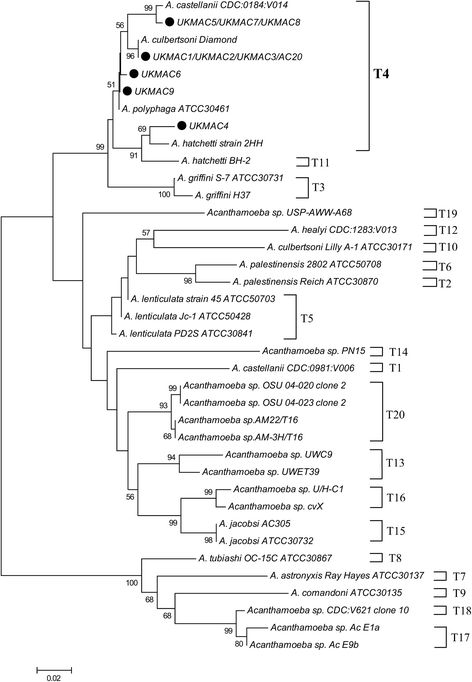
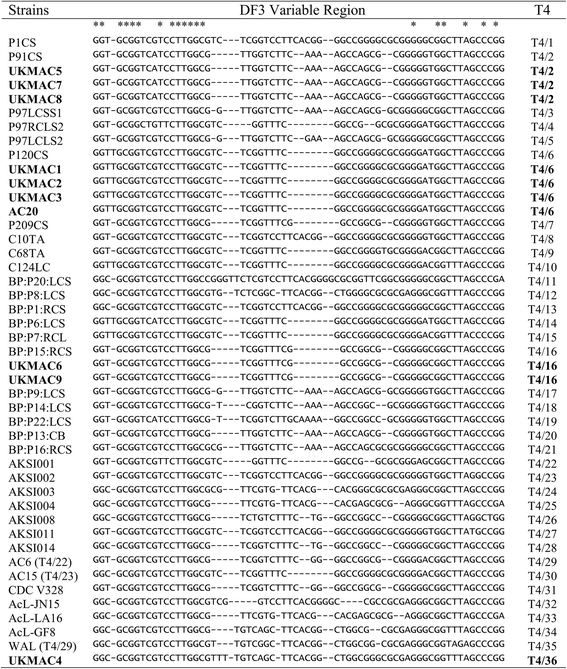

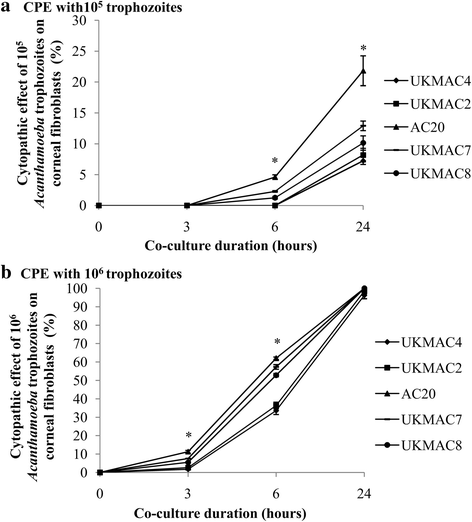

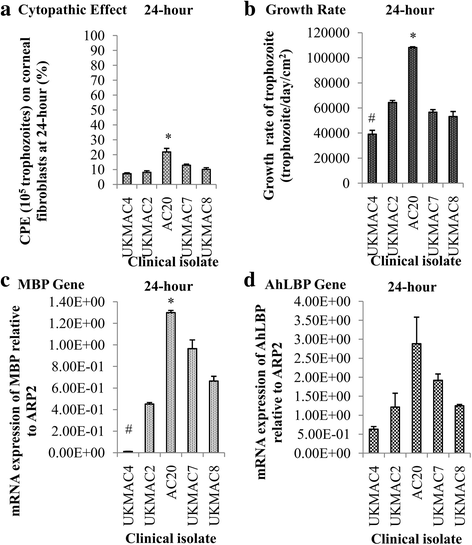
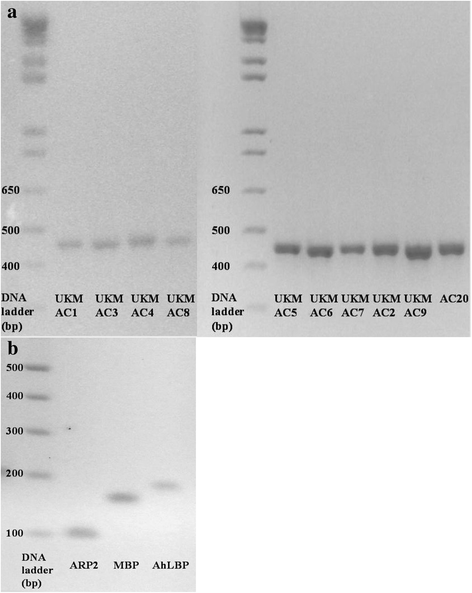
Similar articles
-
Genotypic heterogeneity based on 18S-rRNA gene sequences among Acanthamoeba isolates from clinical samples in Italy.Exp Parasitol. 2014 Nov;145 Suppl:S46-9. doi: 10.1016/j.exppara.2014.05.009. Epub 2014 May 20. Exp Parasitol. 2014. PMID: 24858926
-
Morphological, genotypic, and physiological characterization of Acanthamoeba isolates from keratitis patients and the domestic environment in Vitoria, Espírito Santo, Brazil.Exp Parasitol. 2013 Sep;135(1):9-14. doi: 10.1016/j.exppara.2013.05.013. Epub 2013 Jun 6. Exp Parasitol. 2013. PMID: 23748160
-
Acanthamoeba T4 genotype associated with keratitis infections in Tunisia.Parasitol Res. 2013 Jan;112(1):401-5. doi: 10.1007/s00436-012-3149-6. Epub 2012 Oct 5. Parasitol Res. 2013. PMID: 23052779
-
Molecular phylogeny of acanthamoeba.Korean J Parasitol. 2009 Oct;47 Suppl(Suppl):S21-8. doi: 10.3347/kjp.2009.47.S.S21. Korean J Parasitol. 2009. PMID: 19885332 Free PMC article. Review.
-
Pathogenesis of acanthamoeba keratitis.Ocul Surf. 2010 Apr;8(2):70-9. doi: 10.1016/s1542-0124(12)70071-x. Ocul Surf. 2010. PMID: 20427010 Free PMC article. Review.
Cited by
-
Acanthamoeba species from a post-covid patient with CSF rhinorrhea; a next possible post covid menace? A case report.Indian J Med Microbiol. 2023 Mar-Apr;42:100-102. doi: 10.1016/j.ijmmb.2022.09.014. Epub 2022 Oct 14. Indian J Med Microbiol. 2023. PMID: 36244850 Free PMC article.
-
Validation of reference genes for the normalization of RT-qPCR gene expression in Acanthamoeba spp.Sci Rep. 2020 Jun 25;10(1):10362. doi: 10.1038/s41598-020-67035-0. Sci Rep. 2020. PMID: 32587282 Free PMC article.
-
Taurine, a Component of the Tear Film, Exacerbates the Pathogenic Mechanisms of Acanthamoeba castellanii in the Ex Vivo Amoebic Keratitis Model.Pathogens. 2023 Aug 16;12(8):1049. doi: 10.3390/pathogens12081049. Pathogens. 2023. PMID: 37624009 Free PMC article.
-
Paradigms of Protist/Bacteria Symbioses Affecting Human Health: Acanthamoeba species and Trichomonas vaginalis.Front Microbiol. 2021 Jan 7;11:616213. doi: 10.3389/fmicb.2020.616213. eCollection 2020. Front Microbiol. 2021. PMID: 33488560 Free PMC article. Review.
-
Identification and biochemical characterisation of Acanthamoeba castellanii cysteine protease 3.Parasit Vectors. 2020 Nov 23;13(1):592. doi: 10.1186/s13071-020-04474-8. Parasit Vectors. 2020. PMID: 33228764 Free PMC article.
References
-
- Anisah N, Yusof S, Rahimah I, Norhayati M. Isolation of Acanthamoeba spp. from domestic water tap. Trop Biomed. 2003;20(1):87–89.
Publication types
MeSH terms
Substances
Grants and funding
LinkOut - more resources
Full Text Sources
Other Literature Sources
Miscellaneous

